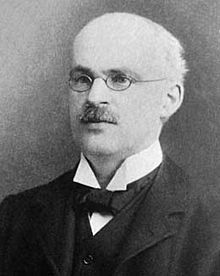John Edward Campbell facts for kids
Quick facts for kids
John Edward Campbell
|
|
|---|---|
 |
|
| Born | 27 May 1862 Lisburn, Ireland
|
| Died | 1 October 1924 (aged 62) Oxford, Oxfordshire, England
|
| Known for | Campbell's theorem Baker–Campbell–Hausdorff formula |
| Awards | Fellow of the Royal Society (1905) |
| Scientific career | |
| Fields | Mathematics |
John Edward Campbell (born May 27, 1862, in Lisburn, Ireland – died October 1, 1924, in Oxford, Oxfordshire, England) was a brilliant mathematician. He is most famous for his important work on a complex math idea called the Baker-Campbell-Hausdorff formula. This formula helps scientists and mathematicians understand how certain mathematical operations work together.
Contents
A Life in Mathematics
John Edward Campbell was born into a family where his father was also a doctor named John Campbell. John Edward started his studies at the Methodist College Belfast in Belfast. Later, he attended Queen's University Belfast, where he graduated in 1884.
Oxford University Years
After his graduation, John won a special scholarship to study at Oxford University. He joined Hertford College. While there, he achieved several academic successes. In 1885, he won the Junior Mathematical University Scholarship. By 1887, he became a College Fellow. He then earned a Senior Scholarship in 1888. Eventually, he became a tutor at the college. Campbell was known as a very kind and dedicated teacher. He also strongly supported education for women, which was quite progressive for his time.
His Big Math Discovery
Campbell made his most important contribution to mathematics in 1897. He introduced a special formula for multiplying certain mathematical expressions in an area called Lie algebras. Imagine Lie algebras as a way to study symmetry in math. Other famous mathematicians, like Henri Poincaré and Henry Frederick Baker, later built upon his ideas. Finally, Felix Hausdorff helped organize these ideas in a geometric way. Because of their combined efforts, this important math tool became known as the Baker-Campbell-Hausdorff formula.
Later Achievements
In 1903, Campbell wrote a book called Introductory Treatise on Lie's Theory of Finite Continuous Transformation Groups. In this book, he helped make the ideas of another mathematician, Sophus Lie, more popular and easier to understand. In 1905, he was chosen as a Fellow of the Royal Society, which is a very high honor for scientists. He also led the London Mathematical Society as its president from 1918 to 1920.
Interestingly, in 1917, Campbell even tutored the famous writer C. S. Lewis. He helped Lewis with his math exams, which were needed to get into Oxford University. Just before he passed away, Campbell was invited by Cambridge University to help examine their difficult math exams, the Cambridge Mathematical Tripos. This was a big honor, as he was the first mathematician from Oxford to be asked.
Family Life
John Campbell married Sarah Hardman in late 1889. She was born around 1862. They had three sons and one daughter, all born in Oxford:
- John Maurice Hardman Campbell (1891–1973)
- William Percy Campbell (May 2, 1894 – October 24, 1914)
- Patrick James Campbell (December 22, 1897 – ?)
- Dorothea Mary Hardman Campbell (December 28, 1902 – ?)
Their son, William, started at Oxford College in October 1913. However, he soon joined the army to fight in World War I. He served as a Second Lieutenant with the Wiltshire Regiment. Sadly, he was killed in action only a few weeks after going to the front lines in October 1914.

